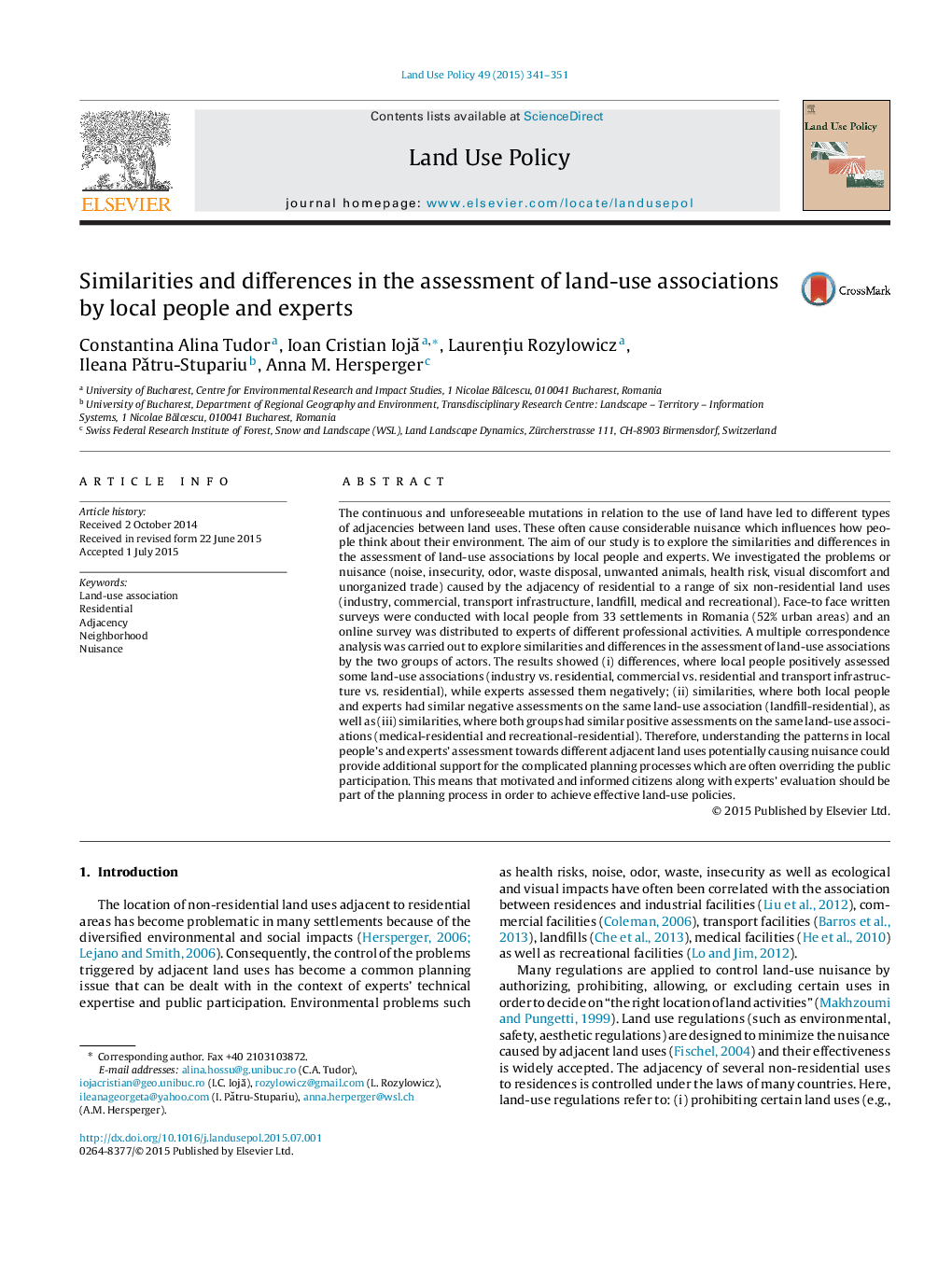| کد مقاله | کد نشریه | سال انتشار | مقاله انگلیسی | نسخه تمام متن |
|---|---|---|---|---|
| 6547775 | 160102 | 2015 | 11 صفحه PDF | دانلود رایگان |
عنوان انگلیسی مقاله ISI
Similarities and differences in the assessment of land-use associations by local people and experts
ترجمه فارسی عنوان
شباهت ها و تفاوت ها در ارزیابی انجمن های استفاده از زمین توسط مردم و کارشناسان محلی
دانلود مقاله + سفارش ترجمه
دانلود مقاله ISI انگلیسی
رایگان برای ایرانیان
کلمات کلیدی
انجمن استفاده از زمین، مسکونی وابستگی، محله عصبانیت،
ترجمه چکیده
جهش های مداوم و غیر قابل پیش بینی در ارتباط با استفاده از زمین منجر به انواع مختلفی از تقابل های بین استفاده از زمین شده است. این اغلب موجب ناراحتی قابل ملاحظه ای می شود که بر چگونگی مردم در مورد محیط زیست تاثیر می گذارد. هدف از مطالعه ما بررسی رابطه و تفاوت در ارزیابی انجمن های استفاده از زمین توسط مردم محلی و کارشناسان است. ما مشکلات و یا ناراحتی (سر و صدا، ناامنی، بوی، دفع زباله، حیوانات ناخواسته، خطر سلامتی، ناراحتی بصری و تجارت غیر سازمان یافته) را بررسی کردیم که ناشی از تقریبی مسکونی به طیف وسیعی از شش کاربری غیر مسکونی (صنعت، تجاری، حمل و نقل زیرساخت، دفن زباله، پزشکی و تفریحی). با جمعیت محلی از 33 شهرک در رومانی (52٪ مناطق شهری) و بررسی آنلاین به کارشناسان فعالیت های حرفه ای مختلف، مردم به صورت رسمی بررسی شدند. تجزیه و تحلیل مکاتبات متعدد برای بررسی شباهت ها و تفاوت ها در ارزیابی انجمن های کاربری زمین توسط دو گروه بازیگران انجام شده است. نتایج نشان داد (من) تفاوت ها، که در آن مردم محلی برخی از انجمن های کاربری زمین (صنعت در مقابل ساختمان های مسکونی، تجاری در مقابل مسکونی و حمل و نقل در مقابل مسکونی) مثبت ارزیابی می کردند، در حالی که کارشناسان آنها را منفی می دانستند؛ (2) شباهت ها، که در آن هر دو مردم محلی و کارشناسان ارزیابی منفی مشابه در همان انجمن استفاده از زمین (محل دفن زباله)، و نیز (3) شباهت ها، که در آن هر دو گروه ها در مورد همان انجمن های کاربری زمین (پزشکی-مسکونی و تفریحی-مسکونی). بنابراین درک الگوهای الگوهای ارزیابی مردم و کارشناسان نسبت به مناطق مختلف مجاور زمین که به طور بالقوه موجب ایجاد مزاحمت می شود، می تواند حمایت بیشتری از پروسه های برنامه ریزی پیچیده ای که اغلب مشارکت عمومی را بر عهده دارند، حمایت کند. این به این معنی است که شهروندان انگیزه و آگاهانه همراه با ارزیابی کارشناسان باید بخشی از روند برنامه ریزی برای دستیابی به سیاست های موثر در زمینه استفاده از زمین باشند.
موضوعات مرتبط
علوم زیستی و بیوفناوری
علوم کشاورزی و بیولوژیک
جنگلداری
چکیده انگلیسی
The continuous and unforeseeable mutations in relation to the use of land have led to different types of adjacencies between land uses. These often cause considerable nuisance which influences how people think about their environment. The aim of our study is to explore the similarities and differences in the assessment of land-use associations by local people and experts. We investigated the problems or nuisance (noise, insecurity, odor, waste disposal, unwanted animals, health risk, visual discomfort and unorganized trade) caused by the adjacency of residential to a range of six non-residential land uses (industry, commercial, transport infrastructure, landfill, medical and recreational). Face-to face written surveys were conducted with local people from 33 settlements in Romania (52% urban areas) and an online survey was distributed to experts of different professional activities. A multiple correspondence analysis was carried out to explore similarities and differences in the assessment of land-use associations by the two groups of actors. The results showed (i) differences, where local people positively assessed some land-use associations (industry vs. residential, commercial vs. residential and transport infrastructure vs. residential), while experts assessed them negatively; (ii) similarities, where both local people and experts had similar negative assessments on the same land-use association (landfill-residential), as well as (iii) similarities, where both groups had similar positive assessments on the same land-use associations (medical-residential and recreational-residential). Therefore, understanding the patterns in local people's and experts' assessment towards different adjacent land uses potentially causing nuisance could provide additional support for the complicated planning processes which are often overriding the public participation. This means that motivated and informed citizens along with experts' evaluation should be part of the planning process in order to achieve effective land-use policies.
ناشر
Database: Elsevier - ScienceDirect (ساینس دایرکت)
Journal: Land Use Policy - Volume 49, December 2015, Pages 341-351
Journal: Land Use Policy - Volume 49, December 2015, Pages 341-351
نویسندگان
Constantina Alina Tudor, Ioan Cristian IojÄ, LaurenÅ£iu Rozylowicz, Ileana PÇtru-Stupariu, Anna M. Hersperger,
